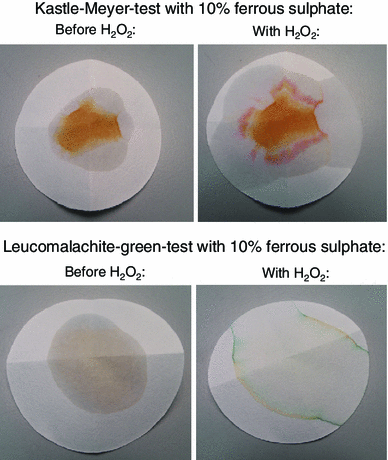How Do Presumptive Blood Tests Detect Evidence?
Human Blood Testing- Presumptive Tests
Keywords searched by users: How do presumptive blood tests work presumptive test example, confirmatory testing, presumptive test vs confirmatory test, types of presumptive blood tests, 3 types of presumptive blood tests, what is a presumptive test, what is a presumptive blood test, what are the limitations of presumptive tests?
What Are The Methods Of Presumptive Blood Testing?
Let’s provide a more comprehensive overview of presumptive blood testing methods, including the missing information:
Presumptive blood testing methods are essential tools in forensic science and crime scene investigation to detect the presence of blood or other bodily fluids at a crime scene. These methods help investigators quickly identify potential evidence for further analysis. Here are some examples of presumptive blood testing methods:
-
Kastle-Meyer Test: This test is used to detect the presence of blood. It involves applying a reagent, typically phenolphthalein and hydrogen peroxide, to a suspected bloodstain. If blood is present, the solution will change from colorless to pink.
-
Benzidine Test: The benzidine test is another method to confirm the presence of blood. It uses benzidine reagent, which changes from clear to blue when it comes into contact with blood.
-
Acid Phosphatase Test: This test is specific for semen detection. It detects the presence of acid phosphatase, an enzyme found in high concentrations in seminal fluid.
-
Cobalt Thiocyanate Test: This test is utilized for identifying cocaine. It involves the use of cobalt thiocyanate reagent, which forms a distinctive blue color when it reacts with cocaine.
-
Duquenois-Levine Reagent: This reagent is employed to detect cannabis (marijuana). It is a multi-step test involving chemical reactions that result in color changes when cannabis is present.
-
Malachite Green Test: Similar to the Kastle-Meyer and benzidine tests, the malachite green test is used for blood detection. Malachite green reagent changes color when it encounters bloodstains.
-
Marquis Reagent: This reagent is commonly used for testing narcotics. It produces various color reactions depending on the type of narcotic present, aiding in their identification.
By employing these presumptive blood testing methods, investigators can quickly identify potential bloodstains and other bodily fluids at crime scenes, providing crucial initial evidence for further forensic analysis.
What Are The 3 Types Of Presumptive Tests?
This chapter offers a comprehensive exploration of different presumptive methods employed in the field of forensic science. These methods serve as preliminary tests to detect the presence of specific substances or evidence in a given sample. There are three primary types of presumptive tests, each with its own unique approach and application. These three types include:
-
Colorimetric Tests: Colorimetric tests involve the use of chemical reagents that produce specific color reactions when they come into contact with certain substances. By observing the color change, forensic scientists can make initial determinations about the presence or absence of particular compounds or elements in a sample.
-
Immunoassay Tests: Immunoassay tests rely on the principles of immunology to identify and quantify specific molecules, such as proteins or drugs, in a sample. These tests utilize antibodies or antigens to bind with the target substance, leading to detectable reactions that provide valuable information for forensic analysis.
-
In-Field Testing: In-field testing methods are designed for quick, on-site analysis in forensic investigations. These tests are typically portable and user-friendly, allowing law enforcement and forensic professionals to obtain rapid results without the need for sophisticated laboratory equipment. In-field tests are especially valuable for preliminary assessments at crime scenes or during drug enforcement operations.
By exploring these three fundamental types of presumptive tests, this chapter aims to equip readers with a deeper understanding of the diverse tools and techniques available to forensic scientists when conducting initial examinations of evidence.
What Is A Presumptive Blood Test And Why Is It So Useful?
A presumptive blood test serves the crucial role of initially assessing the likelihood of the presence of blood in a given sample. When this test yields a positive result, it suggests the potential presence of blood, warranting further investigation. However, to definitively confirm the presence of blood, a subsequent confirmatory test is conducted. If the confirmatory test also produces a positive outcome, it confirms the actual presence of blood in the sample. In summary, a presumptive blood test serves as an initial indicator, while a confirmatory test offers conclusive proof of the presence of this vital body fluid. This two-step process is vital for forensic investigations and medical diagnostics, ensuring accuracy and reliability in identifying blood-related evidence or health conditions.
Discover 10 How do presumptive blood tests work

Categories: Aggregate 22 How Do Presumptive Blood Tests Work
See more here: c3.castu.org

Presumptive tests react with the hemoglobin of all blood (human and animal) to catalyze the oxidation of a chromogenic compound, which produces a color change [25]. A positive reaction will result in the identification of the sample as possibly blood but not necessarily human blood.This chapter provides an overview of various presumptive methods in forensic science and includes: colourimetric, immunoassay, and in-field testing.
- Acid phosphatase test for semen.
- Cobalt thiocyanate test for cocaine.
- Duquenois-Levine reagent for cannabis.
- Kastle-Meyer test for blood.
- Malachite green test for blood.
- Marquis reagent for narcotics.
- Benzidine test for blood which changes from clear to blue in color with the presence of blood.
Learn more about the topic How do presumptive blood tests work.
- Presumptive and Confirmatory Blood Testing – ScienceDirect
- Presumptive and confirmatory tests – Wikipedia
- Chapter 2: Presumptive Testing – Forensic Toxicology
- Presumptive and Confirmatory Blood Testing – ScienceDirect.com
- A Comparison of Four Presumptive Tests for the Detection of Blood on …
- Assessing the impact of common forensic presumptive tests … – CORE
See more: c3.castu.org/category/fashion